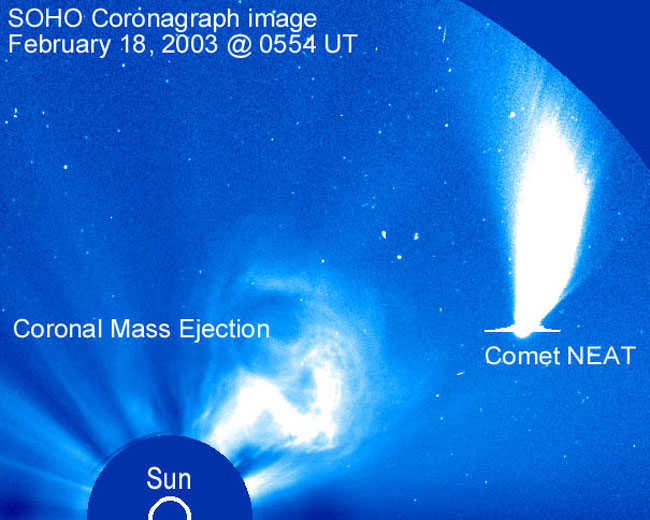Explanation: As Comet NEAT flared last week, the Sun roared. Just as the comet swooped inside the orbit of Mercury and developed a long and flowing tail of gas and dust, the Sun emitted a huge Coronal Mass Ejection (CME). Neither the fortuitous hot ball of solar gas nor the intense glare of sunlight appeared to disrupt the comet's nucleus. The action was too close to the Sun to be easily visible by humans, but the orbiting Sun-pointing SOHO satellite had a clear view of the celestial daredevil show. The above image was taken on February 18 when the comet was so bright it created an artificial horizontal streak on the camera image. During the encounter, Comet NEAT, official designation (C/2002 V1), brightened to second magnitude. An opaque disk blocked the Sun's image. The now-outbound comet remains bright but will surely fade as it moves away from the Sun. Nevertheless, Comet NEAT will likely be visible with binoculars to southern hemisphere observers for the next month.
1999 2000 2001 2002 2003 2004 2005 2006 2007 2008 2009 2010 2011 2012 2013 2014 2015 2016 2017 2018 2019 2020 2021 2022 2023 2024 2025 |
Yanvar' Fevral' Mart Aprel' Mai Iyun' Iyul' Avgust Sentyabr' Oktyabr' Noyabr' Dekabr' |
NASA Web Site Statements, Warnings, and Disclaimers
NASA Official: Jay Norris. Specific rights apply.
A service of: LHEA at NASA / GSFC
& Michigan Tech. U.
|
Publikacii s klyuchevymi slovami:
Comet NEAT - CME - Sun - komety - Solnce - koronal'nyi vybros
Publikacii so slovami: Comet NEAT - CME - Sun - komety - Solnce - koronal'nyi vybros | |
Sm. takzhe:
Vse publikacii na tu zhe temu >> | |
